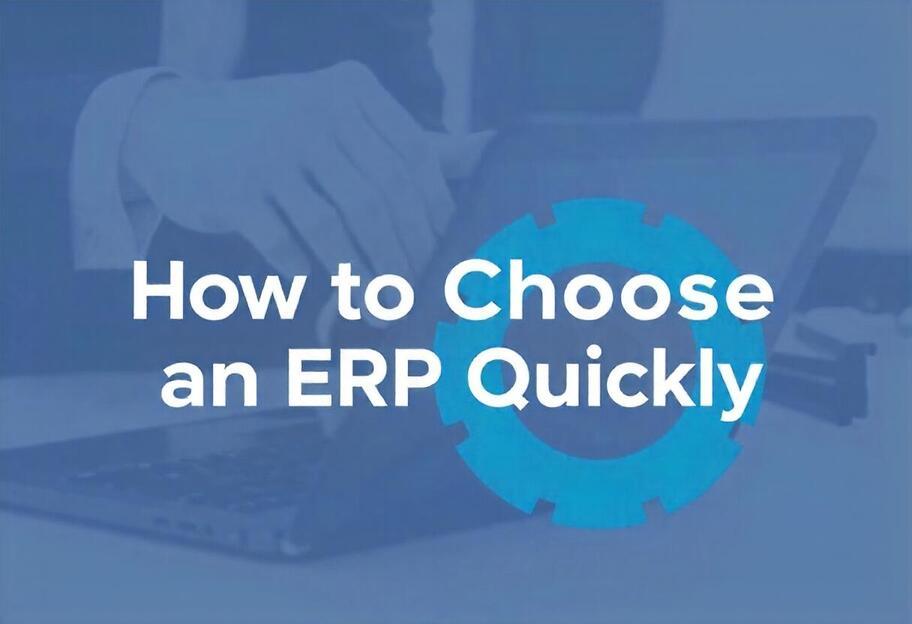How to Choose an ERP Quickly: Insights from Quark Cyber Systems (QCS)
Choosing an ERP doesn’t have to be slow. At QCS, we offer a practical, data-driven approach to help you quickly evaluate and select the right ERP for your business needs.

Fast-Track Your ERP Selection: Proven Tips from Quark Cyber Systems
Choosing an ERP system is a pivotal decision for any business, but it doesn’t need to be a long, drawn-out process. While ERP implementations can feel overwhelming, particularly with multiple divisions and stakeholders involved, there are ways to streamline the selection process. At Quark Cyber Systems (QCS), we’ve refined the ERP evaluation and selection process to help businesses make quick yet informed decisions. Here’s how we recommend choosing the right ERP, without unnecessary delays:
| Struggling to choose the right ERP system? Don't worry, we've got you covered! Here's your ultimate roadmap to selecting the perfect ERP solution. |
1. Align Stakeholders Early
One of the first steps to speeding up ERP selection is ensuring that all stakeholders are aligned from the get-go. ERP implementation means potentially big changes. To avoid resistance, bring key department heads and decision-makers into the conversation early. Start by communicating the tangible benefits the ERP system will bring to their daily operations, such as automation, improved reporting, or better data accuracy.
A successful ERP selection process hinges on buy-in from all stakeholders. If the finance department sees value in real-time reporting, or the manufacturing team gets excited about streamlined production scheduling, the entire organization will be more receptive to adopting the new system. Create transparency by hosting internal workshops or presentations that focus on specific pain points and how the ERP can resolve them.
2. Identify Crucial Reports and KPIs for the Implementation
Before diving into product demos or evaluating potential vendors, take time to identify the critical reports and KPIs that drive your business. What metrics are essential for you to track? Whether it’s financial forecasting, inventory turnover, or sales pipeline management, having clarity on these points ensures the ERP you choose will align with your operational goals.
It’s important to understand that an ERP system’s value lies in its ability to process and present data in a way that supports decision-making. Work with your teams to gather real data, and run it through the ERP system’s reporting engine to assess how well it meets your needs. If the ERP struggles with your most critical reports, it’s likely not the right fit.
3. Conduct a Targeted Proof of Concept (PoC)
Once you’ve identified your must-have reports and KPIs, it’s time to see how potential ERP systems perform in a real scenario. At QCS, we recommend running a proof of concept (PoC) on one or two core business processes to evaluate the ERP's capabilities.
For example, if you’re in the manufacturing or trading sector, simulate an actual business cycle. Place an order, initiate a manufacturing entry, and run the corresponding reports to see how the ERP handles these tasks. The aim of the PoC is to let your team experience the system firsthand, not just watch a demo. This hands-on approach provides practical insight into the ERP’s usability and effectiveness, especially when it comes to your business-critical operations.
| Looking for the perfect ERPNext partner? Our guide makes it easy to choose the right partner and set your business up for success! |
4. Gain Stakeholder Sign-Off as the PoC Progresses
A key aspect of streamlining ERP selection is gaining incremental sign-offs from stakeholders as the proof of concept unfolds. Rather than waiting until the entire PoC is complete, collect feedback from key users after each cycle or test. This ensures you’re consistently addressing concerns, while also building confidence in the system.
If you’re evaluating multiple systems, compare each PoC's results in ease of use, quality of reports, and system performance. This iterative feedback loop helps cut down on delays since stakeholders will already be aligned on the strengths and weaknesses of each option.
5. Make Your Final Decision Based on Data, Not Demos
Once the PoC is complete and stakeholders have signed off, the next step is to make your final decision. Often, companies get bogged down in lengthy product demos or endless rounds of feature comparisons. Instead, we advise basing your final decision on the data collected during the PoC-how well the system performed against your key business functions and KPIs.
By focusing on actual results, rather than sales pitches or demos, you’ll be in a much stronger position to choose the right ERP quickly. Remember, the goal is to find a system that solves your core business challenges, not one that dazzles with non-essential features.
Our Two Cents
At QCS, we believe that the quickest path to selecting an ERP is to prioritize practical testing over theory. By aligning stakeholders early, identifying critical reports and KPIs, running a focused proof of concept, and collecting continuous feedback, you can cut through the complexity and make a fast, informed decision. ERP selection doesn’t have to be a drawn-out process-by using real-world data and processes, you can evaluate an ERP’s true value in a matter of weeks, not months.
| Need to make a quick yet informed ERP decision? Let QCS guide you! Connect with us today, and we'll help you find the perfect ERP solution tailored to your business needs. |
Deepa Ramachandran
Juggling tech trends, art projects, and a love for storytelling—let’s explore it all together!

No comments yet. Login to start a new discussion Start a new discussion